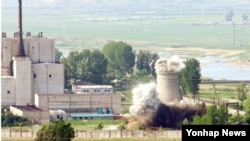Washington (VOA) – North Korea could revive the Yongbyon nuclear reactor in 4 to 6 months and get enough fissile material for a nuclear weapon in less than 2 years, according to Olli Heinonen, former Deputy Director-General for Safeguards at the International Atomic Energy Agency (IAEA).
“I would say that it would take 4~6 months to have it back in operation and if North Korea starts the reactor by the end of this year, they will have enough material for additional nuclear bomb by the end of the next year,” said Heinonen in a telephone interview with VOA’s Korean Service on Wednesday.
This assessment is quite different from those of some experts predicting it might take up to 3 years for North Korea to restart the 5 MW reactor.
This means also if the reactor continues to be in operation, it will produce plutonium enough for one nuclear bomb every year from then on.
On Tuesday, the North announced it would restart the 5MW plutonium reactor it had shut down in 2007.
The North’s announcement followed its Workers’ Party earlier pledge to keep nuclear weapons, describing them as the “nation’s life.”
Heinonen says available information on the North’s preparatory work on re-opening the reactor is extremely limited suggesting that they could have made progress during the intervening years.
The IAEA’s last on-site information on the North’s nuclear activity dates back four years when all IAEA inspectors were forced to leave by North Korea in April 2009 .
Heinonen also said that the North might “modify the Yongbyon reactor as needed following the example of Syria,” referring to the Dair Alzour reactor.
Dair Alzour, also referred to as Al-Kibar, does not need a cooling tower and uses river water as coolant. Therefore if North Korea adopts the cooling system of Al-Kibar to Yongbyon, it would shorten the time required to restart because it doesn’t need to rebuild the cooling tower that was destroyed in 2008 as part of an agreement with the US. North Korea allegedly had helped the Syrian government build the Al-Kibar reactor before it was bombed by Israel.
Heinonen, former head of the nuclear watchdog’s safeguards department, also pointed out that North Korea’s announcement raises another serious concern, which is NK’s production of Highly Enriched Uranium for nuclear weapons.
Heinonen said he can’t rule out the possibility that Pyongyang is running additional highly enriched uranium facilities other than the one shown to American scientists in November, 2010.
He said, “I think there has to be at least one more place in North Korea where they have done research and development.”
Heinonen is a Senior Fellow at Harvard University’s Belfer Center for Science and International Affairs. He left the IAEA in August 2010 after serving 27 years at the agency.
Reported in Korean by Mi Jeong Hibbitts for VOA Korean Service. Written in English by Jeewon Lee.
To contact the editor responsible for this story: news editors at VOA’s Korean Service Korean-editors@voanews.com
“I would say that it would take 4~6 months to have it back in operation and if North Korea starts the reactor by the end of this year, they will have enough material for additional nuclear bomb by the end of the next year,” said Heinonen in a telephone interview with VOA’s Korean Service on Wednesday.
This assessment is quite different from those of some experts predicting it might take up to 3 years for North Korea to restart the 5 MW reactor.
This means also if the reactor continues to be in operation, it will produce plutonium enough for one nuclear bomb every year from then on.
On Tuesday, the North announced it would restart the 5MW plutonium reactor it had shut down in 2007.
The North’s announcement followed its Workers’ Party earlier pledge to keep nuclear weapons, describing them as the “nation’s life.”
Heinonen says available information on the North’s preparatory work on re-opening the reactor is extremely limited suggesting that they could have made progress during the intervening years.
The IAEA’s last on-site information on the North’s nuclear activity dates back four years when all IAEA inspectors were forced to leave by North Korea in April 2009 .
Heinonen also said that the North might “modify the Yongbyon reactor as needed following the example of Syria,” referring to the Dair Alzour reactor.
Dair Alzour, also referred to as Al-Kibar, does not need a cooling tower and uses river water as coolant. Therefore if North Korea adopts the cooling system of Al-Kibar to Yongbyon, it would shorten the time required to restart because it doesn’t need to rebuild the cooling tower that was destroyed in 2008 as part of an agreement with the US. North Korea allegedly had helped the Syrian government build the Al-Kibar reactor before it was bombed by Israel.
Heinonen, former head of the nuclear watchdog’s safeguards department, also pointed out that North Korea’s announcement raises another serious concern, which is NK’s production of Highly Enriched Uranium for nuclear weapons.
Heinonen said he can’t rule out the possibility that Pyongyang is running additional highly enriched uranium facilities other than the one shown to American scientists in November, 2010.
He said, “I think there has to be at least one more place in North Korea where they have done research and development.”
Heinonen is a Senior Fellow at Harvard University’s Belfer Center for Science and International Affairs. He left the IAEA in August 2010 after serving 27 years at the agency.
Reported in Korean by Mi Jeong Hibbitts for VOA Korean Service. Written in English by Jeewon Lee.
To contact the editor responsible for this story: news editors at VOA’s Korean Service Korean-editors@voanews.com






